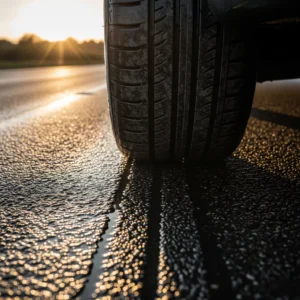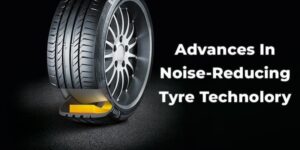There are numbers and letters on the side of your car’s tyre. Have you ever seen them? They might look hard to understand, but they tell you everything you need to know about your tire!
Writing on the rim of your tyre is like an ID card for it. They tell you important things like the size of the tire, its speed number, and how much weight it can hold. If you know what these signs mean, you can pick the right tires for your car, make it safer, and even save money by making sure you get the best gas mileage and performance.
Understanding Tyre Sidewall Markings
The numbers and names on the side of your tire are called tire sidewall markings. They might look hard to understand, but they’re just ways to tell you important things about the tire’s size, type, and performance.
These lines are like a tire’s passport—they show you where it fits, how fast it can go, how much weight it can hold, and other helpful information.
What Information Do These Markings Provide?
Here are the key things you’ll find on a tyre’s sidewall:
Tyre Size
This tells you the width, aspect ratio, and wheel diameter.
Load Index
Shows how much weight the tyre can carry.
Speed Rating
Tells you the maximum speed the tyre is designed for.
Tyre Type
Whether it’s for summer, winter, or all seasons.
Manufacturing Date
Helps you know how old the tyre is.
Brand & Model
The name of the tyre manufacturer and model type.
These markings help you pick the right tyres for your car, ensuring better performance, safety, and fuel efficiency. Don’t worry—we’ll explain each part in detail so you can read your tyre like a pro! 🚗
How to Read Tyre Size
When you look at your tyre, you’ll see a code that looks something like this:
🛞 205/55 R16 91V
This may seem confusing, but don’t worry! Let’s break it down step by step.
1️⃣ Tyre Width (205) – How Wide is Your Tyre?
The first number (205) tells you the width of the tyre in millimeters. This is the distance from one side of the tyre to the other.
- Wider tyres (e.g., 225mm) give better grip but may reduce fuel efficiency.
- Narrower tyres (e.g., 175mm) are more fuel-efficient but may have less grip.
2️⃣ Aspect Ratio (55) – Tyre Height Matters!
The second number (55) is the aspect ratio, which tells you how tall the tyre’s sidewall is.
- Aspect Ratio Formula: It is a percentage of the tyre’s width.
- If a tyre has an aspect ratio of 55, it means the sidewall height is 55% of the width.
🔹 Higher aspect ratio (e.g., 70+) → More comfortable ride, better for rough roads.
🔹 Lower aspect ratio (e.g., 40-50) → Sporty handling, better grip, but a stiffer ride.
3️⃣ Construction Type (R) – Radial or Something Else?
The letter R stands for Radial tyres, which are the most common type today.
Other types:
- D (Diagonal) – Used for old vehicles and motorcycles.
- B (Bias Belted) – Rarely used today.
Radial tyres are better because they offer:
✔️ Longer lifespan
✔️ Better fuel efficiency
✔️ Improved grip and handling
4️⃣ Rim Diameter (16) – What Wheel Size Fits?
The next number (16) is the rim diameter in inches.
🚗 If your car has 16-inch wheels, you need tyres with 16 in this part of the code.
- Bigger wheels (e.g., 18″) look sporty but can make the ride stiffer.
- Smaller wheels (e.g., 14″) give a smoother ride but may not handle as well.
5️⃣ Load Index & Speed Rating (91V) – How Much Weight & Speed?
- 91 = Load Index: Tells you how much weight the tyre can safely carry.
- Example: 91 = 615 kg per tyre
- Always check your car manual for the right load index!
- V = Speed Rating: The maximum speed the tyre can handle.
- H = 130 mph (210 km/h)
- V = 149 mph (240 km/h)
- W = 168 mph (270 km/h)
Make sure you get a speed rating that matches or exceeds your car’s needs.
What Do the Letters and Numbers Mean on Tyres?
When you look at a tyre, you’ll see a mix of letters and numbers printed on the side. These aren’t just random—they tell you important details about the tyre’s size, strength, and performance. Let’s break them down in an easy way!
📌 Tyre Letter Meaning
✔ R – Radial Tyre
Most modern tyres are radial, meaning they are designed for durability and better grip.
✔ XL – Extra Load
Tyres marked with XL can carry more weight than standard tyres.
✔ M+S – Mud & Snow
These tyres are better for slippery roads but not the same as full winter tyres.
✔ 3PMSF – Three Peak Mountain Snowflake
This means the tyre meets winter performance standards and is great for snowy roads.
✔ ZR – High-Performance Tyres
Used for sports cars and high-speed driving.)
📌 Tyre Number Meaning
Numbers on the tyre mainly tell you load capacity and speed rating.
✔ Load Index (e.g., 91) – This tells you how much weight a tyre can handle.
- 91 = 615 kg per tyre
- 100 = 800 kg per tyre
✔ Speed Rating (e.g., V) – This shows the maximum speed the tyre is safe for.
- H = 130 mph (210 km/h)
- V = 149 mph (240 km/h)
- W = 168 mph (270 km/h)
🔹 Example: 205/55 R16 91V
- R = Radial tyre
- 91 = Can carry 615 kg
- V = Max speed 149 mph
By understanding these tyre codes, you can choose the right tyres for your car, ensuring safety, better performance, and a smoother ride! 🚗💨
What is Tyre Aspect Ratio?
📌 Definition: What Does Aspect Ratio Mean?
The aspect ratio of a tyre is the height of the tyre’s sidewall compared to its width. It is shown as a percentage.
For example, in 205/55 R16, the number 55 is the aspect ratio. This means the tyre’s sidewall height is 55% of the tyre’s width (205mm).
📌 How is Aspect Ratio Calculated?
👉 Formula:
Aspect Ratio=(Sidewall HeightTyre Width)×100\text{Aspect Ratio} = \left( \frac{\text{Sidewall Height}}{\text{Tyre Width}} \right) \times 100 So, if a tyre is 205mm wide and has a 55% aspect ratio: (205×55100)=112.75mm (sidewall height)\left( \frac{205 \times 55}{100} \right) = 112.75mm \text{ (sidewall height)}📌 How Does Aspect Ratio Affect Performance?
🚗 Quick Example
- SUVs & Off-Road Vehicles: Use higher aspect ratios (65-80) for comfort.
- Sports Cars: Use lower aspect ratios (30-50) for better grip and performance.
Other Important Tyre Markings
Tyres have different markings that give extra information about their performance, type, and suitability for different conditions. Let’s break them down!
📌 Tyre Profile Meaning
The tyre profile refers to the tyre’s sidewall height, which is determined by the aspect ratio.
✔ High Profile Tyres (e.g., 70-80) → Taller sidewalls, more comfortable ride, better for rough roads.
✔ Low Profile Tyres (e.g., 30-55) → Shorter sidewalls, sportier handling, but a stiffer ride.
👉 Example: In a 205/55 R16 tyre, the profile is 55, meaning the sidewall height is 55% of the tyre’s width.
📌 Tyre Code Meaning (UK Standards)
Tyre markings follow UK and EU regulations, which include:
✔ “E” Marking (e.g., E4) → Confirms the tyre meets European safety standards.
✔ DOT Code → Shows where and when the tyre was made.
✔ Noise Rating → Indicates how much road noise the tyre produces (measured in decibels).
📌 XL Tyres – What Does XL Mean on a Tyre?
✔ XL (Extra Load) tyres can carry more weight than standard tyres.
👉 Best for:
- Larger vehicles (SUVs, vans).
- High-performance cars needing stronger tyres.
- Heavier loads without sacrificing performance.
📌 Tyre Side Markings – Winter, Summer, & All-Season Tyres
🛞 Winter Tyres
- Marking: ❄️ (3PMSF – Three Peak Mountain Snowflake)
- Meaning: Designed for icy and snowy conditions.
- Benefit: Better grip in cold weather.
🛞 Summer Tyres
- Marking: ☀️ (No specific symbol, but usually marked with tyre model names)
- Meaning: Performs best in warm weather.
- Benefit: Better grip and fuel efficiency in dry/wet conditions.
🛞 All-Season Tyres
- Marking: 🌦️ (M+S – Mud & Snow, sometimes with 3PMSF)
- Meaning: Designed to work in all weather conditions.
- Benefit: Good balance for year-round use.
Understanding these markings helps you pick the right tyres for safety, performance, and durability—whether you need extra load capacity, winter grip, or summer speed! 🚀
Tyre Codes Chart
Here’s a simple chart to help you understand the most common tyre markings and what they mean:
Marking Meaning
R | Radial Construction (most modern tyres) |
XL | Extra Load (stronger tyres for heavier vehicles) |
91V | Load Index & Speed Rating (91 = max 615 kg, V = max 149 mph) |
DOT | Department of Transportation Code (shows manufacturing details) |
M+S | Mud & Snow (designed for all-season or winter use) |
3PMSF | Three Peak Mountain Snowflake (certified for winter conditions) |
This chart makes it easy to quickly check what different tyre codes mean! 🚗💨
How to Read Tyre Measurements Correctly
Reading tyre measurements might seem complicated at first, but once you know what to look for, it’s easy! Here’s a step-by-step guide to help you decode your tyre’s sidewall like a pro.
📌 Step-by-Step Guide to Decoding Tyre Markings
1️⃣ Find the tyre code on the sidewall
- Example: 205/55 R16 91V
2️⃣ Break it down into key parts:
- 205 → Tyre width (in mm)
- 55 → Aspect ratio (% of width)
- R → Radial construction
- 16 → Rim diameter (in inches)
- 91 → Load index (max weight it can carry)
- V → Speed rating (max safe speed)
Check for special markings:
- M+S (Mud & Snow) → Suitable for all-season use.
- 3PMSF (Three Peak Mountain Snowflake) → Certified for winter.
- XL (Extra Load) → Reinforced tyre for heavier vehicles.
- DOT Code → Tells you when and where the tyre was made.
📌 Choosing the Correct Tyres for Your Car
🔹 Match the tyre size to your car’s requirements (found in the car manual).
🔹 Check the speed rating to ensure it meets your driving needs.
🔹 Look at the load index if you carry heavy loads or passengers.
🔹 Select the right type (summer, winter, or all-season) based on your climate.
Picking the right tyres improves safety, fuel efficiency, and overall driving performance! 🚗💨
Conclusion
Understanding tyre sidewall markings is important for safety, performance, and cost savings. By learning how to read these markings, you can:
✔ Choose the correct tyres for your vehicle.
✔ Ensure a smooth and safe ride with the right load and speed rating.
✔ Avoid unnecessary tyre replacements by knowing what suits your driving needs.
🔹 Final Tip: Regularly check your tyre pressure, tread depth, and condition to keep your tyres in top shape! 🚀
Now that you know how to read tyre markings, you’re ready to make smarter tyre choices! 🎯




